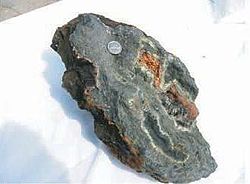
Seafloor massive sulfide deposits
Encyclopedia

Volcanogenic massive sulfide ore deposit
Volcanogenic massive sulfide ore deposits are a type of metal sulfide ore deposit, mainly Cu-Zn-Pb which are associated with and created by volcanic-associated hydrothermal events in submarine environments....
s or VMS deposits. The term has been coined by mineral explorers to differentiate the modern deposit from the ancient.
SMS deposits were first recognised during the exploration of the deep oceans and the mid ocean ridge spreading centers in the early 1960s. Deep ocean bathyspheres and remote operated vehicles have visited and taken samples of black smoker chimneys, and it has been long recognised that such chimneys contain appreciable grades of Cu
Copper
Copper is a chemical element with the symbol Cu and atomic number 29. It is a ductile metal with very high thermal and electrical conductivity. Pure copper is soft and malleable; an exposed surface has a reddish-orange tarnish...
, Pb
Lead
Lead is a main-group element in the carbon group with the symbol Pb and atomic number 82. Lead is a soft, malleable poor metal. It is also counted as one of the heavy metals. Metallic lead has a bluish-white color after being freshly cut, but it soon tarnishes to a dull grayish color when exposed...
, Zn
Zinc
Zinc , or spelter , is a metallic chemical element; it has the symbol Zn and atomic number 30. It is the first element in group 12 of the periodic table. Zinc is, in some respects, chemically similar to magnesium, because its ion is of similar size and its only common oxidation state is +2...
, Ag
Silver
Silver is a metallic chemical element with the chemical symbol Ag and atomic number 47. A soft, white, lustrous transition metal, it has the highest electrical conductivity of any element and the highest thermal conductivity of any metal...
, Au
Gold
Gold is a chemical element with the symbol Au and an atomic number of 79. Gold is a dense, soft, shiny, malleable and ductile metal. Pure gold has a bright yellow color and luster traditionally considered attractive, which it maintains without oxidizing in air or water. Chemically, gold is a...
and other trace metals.
SMS deposits are currently forming in the deep ocean around submarine volcanic arcs, where hydrothermal vent
Hydrothermal vent
A hydrothermal vent is a fissure in a planet's surface from which geothermally heated water issues. Hydrothermal vents are commonly found near volcanically active places, areas where tectonic plates are moving apart, ocean basins, and hotspots. Hydrothermal vents exist because the earth is both...
s exhale sulfide-rich mineralising fluids into the ocean.
SMS deposits are laterally extensive and consist of a central vent mound around the area where the hydrothermal circulation exits, with a wide apron of unconsolidated sulfide silt or ooze which precipitates upon the seafloor.
Economic importance
Economic extraction of SMS deposits is in the theoretical stage, the greatest complication being the extreme water depths at which these deposits are forming. However, apparent vast areas of the peripheral areas of these black smoker zones contain a sulfide ooze which could, theoretically, be vacuumed up off the seafloor.Known SMS deposits
Deep ocean drilling, seismic bathymetryBathymetry
Bathymetry is the study of underwater depth of lake or ocean floors. In other words, bathymetry is the underwater equivalent to hypsometry. The name comes from Greek βαθύς , "deep", and μέτρον , "measure"...
surveys and mineral exploration deep sea drilling has delineated several areas worldwide with potentially economically viable SMS deposits, including:
- Kermadec Volcanic Arc
- Colville Ridge
- Bismarck Sea

